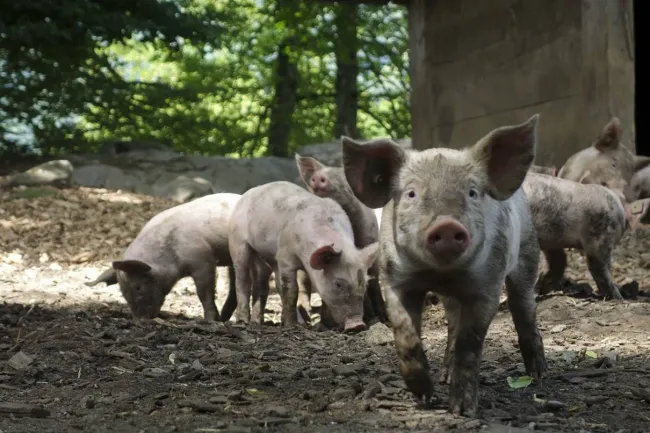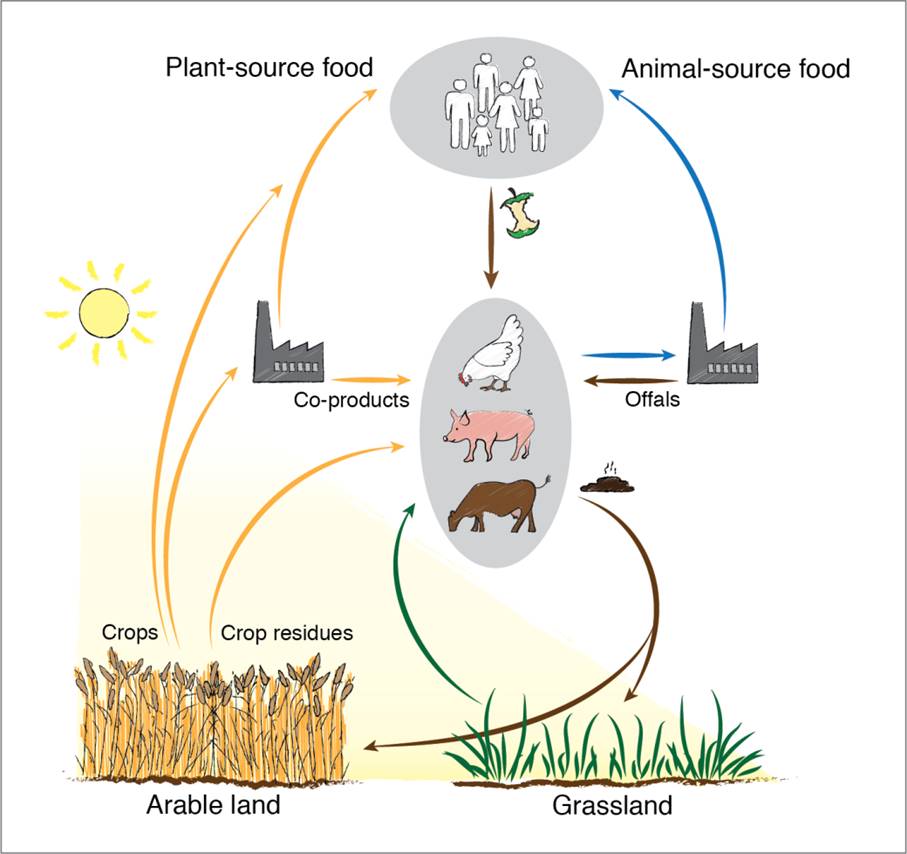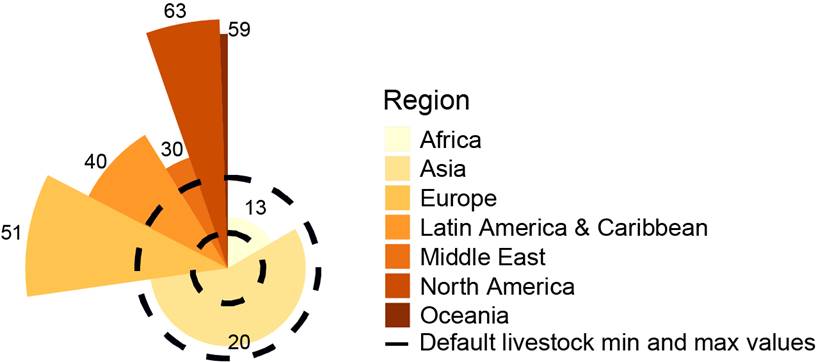This post is written by Hannah van Zanten, assistant professor at Wageningen University, Wageningen, the Netherlands. Her post is based on the paper ‘Defining a land boundary for sustainable animal consumption,’ which was published in Global Change Biology in May 2018.

Image: Felix_Broennimann, Pig domestic suckle, Pixabay, CC0 Creative Commons
The current systems and scale of livestock production have a severe impact on the environment
It is widely recognized that food production, especially animal production, generates a broad range of environmental impacts, increasing the pressure on the Earth’s system. The global animal sector is responsible for about 60% of all human-based greenhouse gas (GHG) emissions from the food system and uses about 40% of all crop land. This crop land is used to produce high quality feed products that we humans could also eat, resulting in a competition for land between feed and food production. As the global population grows, becomes wealthier, and demands more animal-source food (ASF), feed-food competition is likely to worsen. This will further threaten the Earth’s system, as expansion of land leads to many adverse and irreversible environmental consequences.
The future role of animals in the food system is therefore heavily debated within the scientific community. Some argue that to feed an increasing population, we have to produce more ASF with less impact and focus on reducing the environmental footprint of individual ASF products. Others argue that consuming ASF is resource-intensive and conclude that eating no ASF is best for the environment. However, neither of these two approaches consider the role that animals play in recycling biomass unsuited for human consumption back into the food system (although see the FCRN’s Gut Feelings report for a range of scenarios describing different approaches to the livestock problem).

Figure 1. The role of low-cost livestock in the food system. Livestock convert biomass that we cannot or do not want to eat into valuable products, such as animal-source food and manure.
Recycling animals might be the solution
In a new study published in Global Change Biology we suggest that the role of animals in the food system (referred to as low-cost-livestock) should be centred on converting biomass that we cannot or do not want to eat into valuable products, such as nutrient-dense food (meat, milk, and eggs) and manure (Figure 1). Biomass that we cannot or do not want to eat consists of biomass from grassland and leftovers. Leftovers include crop residues left over from harvesting of food crops, co-products left over from industrial processing of plant-source and animal-source food, and losses and waste in the food system. By converting these leftover streams, livestock recycle nutrients back into the food system that otherwise would have been lost in food production. Ruminants can create nutritional value from grasslands by converting grass products into milk, meat, and manure.
Using low-cost livestock avoids the use of arable land
By adopting this approach, arable land should be used primarily for production of food crops, rather than for feed. Low-cost livestock then would not consume human-edible biomass, such as grains, but convert leftovers streams into valuable food, implying that production of livestock feed is largely decoupled from arable land. The availability of these biomass streams for livestock then determines the boundaries for livestock production and consumption. Diets containing animal protein from low-cost livestock, therefore, use less arable land (about one quarter less) than a vegan diet and considerably less arable land than the meat-heavy current diets in high-income countries. In a vegan dietary scenario, crop residues stay on the field to feed the soil-food web; co-products from the food industry become a bio-energy source or are wasted; and grasslands are not utilized for food production. Because animals do not recycle these biomass streams back into the food system, additional crops have to be cultivated to meet the nutritional requirements of the vegan population.
Low-cost livestock contribute to global food security
What might the implications be for human nutrition? We demonstrate that livestock raised under this circular concept could provide a significant, non-negligible part (9–23g/per capita) of our daily protein needs (about 50–60 g/per capita). The current average global supply of terrestrial animal protein (excluding fish) per capita is 27 g per day, while large differences exist between countries. For example, the average European supply is 102 g of protein per day (of which 51 g is terrestrial animal protein), while the average West African supply is 65 g of protein per day (of which just 8 g is terrestrial animal protein). The estimated global amount of daily per capita ASF protein that could be sourced from low-cost livestock (9–23 g/per capita) could potentially fulfill a useful part of our daily protein needs – while enabling arable land to be dedicated to the cultivation of food crops.
Figure 2 shows the current daily supply of protein per capita (g/person/day) in different regions against the range of ASF that could be produced through low-cost livestock. Our results also demonstrate that some, albeit limited, growth in consumption of animal-source food in Africa and Asia would be feasible under these boundary conditions, while reductions in the rest of the world would be necessary to meet land use sustainability criteria. Policies to manage this expansion and contraction of future consumption of animal-source food is essential for achieving sustainable nutrition security.


Figure 2. Current protein supply per person per day per region, compared with the minimum and maximum global value of low-cost livestock (9 and 23g protein per person per day).
Towards a role for low-cost livestock in a sustainable food system
The low-cost livestock concept is based on avoiding the use of arable land to feed livestock. Livestock instead mainly convert grass, and leftovers from arable land into food.
It should however be emphasised – as the FCRN’s Grazed and Confused? report points out – that a large proportion of what is currently grassland was once forest, and to reach biodiversity conservation and carbon sequestration targets it is probable that grazing would need to cease on some of this land. Grazing ruminants also give rise to considerable GHG emissions particularly in the form of methane. These two observations suggest that the level of meat production that might be sustainable from a climate or biodiversity perspective might be lower then what is sustainable from a land and resource-use perspective; a ‘best-fit’ way through all this needs to be navigated and is an area that merits further research.
Finally, we note that this suggested approach is largely dependent on a credible transition of our livestock industries towards a more integrated, circular economy. This represents a radical shift away from current trends and will require increased collaboration between governmental institutions, private industries and civil society in order to put in place the necessary policies, investment and other resources necessary to ensuring livestock can contribute to meeting critical sustainable development goals in the near future.
To start a conversation about this blog post with Hannah van Zanten and other FCRN members in the FCRN Google Group, please click here. You will need to be a member of the group to post to it: you can join here.
Further reading
Van Zanten HHE, Herrero M, Van Hal O, Roos E, Muller A, Garnett T, Gerber P, Schader C, and De Boer IJM (2018) Defining a land boundary for sustainable livestock consumption. Global Change Biology, https://doi.org/10.1111/gcb.14321
Garnett T, Godde C, Muller A, Röös E, Smith P, de Boer IJM, Ermgassen E, Herrero M, van Middelaar C, Schader C and van Zanten H (2017). Grazed and confused? Ruminating on cattle, grazing systems, methane, nitrous oxide, the soil carbon sequestration question. Food Climate Research Network, University of Oxford.
Garnett T (2015). Gut feelings and possible tomorrows: (where) does animal farming fit? Food Climate Research Network, University of Oxford.
Readers may be interested in report Experts say leftovers can be safely fed to pigs and the blog post Using food waste as pig feed, both by FCRN member Karen Luyckz, and the paper Support amongst UK pig farmers and agricultural stakeholders for the use of food losses in animal feed, by FCRN member Erasmus zu Ermgassen.
Official abstract
The need for more sustainable production and consumption of animal-source food is central to the achievement of the sustainable development goals: within this context, wise use of land is a core challenge and concern. A key question in feeding the future world is: how much animal-source food should we eat? We demonstrate that livestock raised under the circular economy concept could provide a significant, non-negligible part (9-23g/per capita) of our daily protein needs (~50-60 g/per capita). This livestock then would not consume human-edible biomass, such as grains, but mainly convert leftovers from arable land and grass resources into valuable food, implying that production of livestock feed is largely decoupled from arable land. The availability of these biomass streams for livestock then determines the boundaries for livestock production and consumption. Under this concept, the competition for land for feed or food would be minimized and compared to no animal-source food, including some animal-source food in the human diet could free up about one quarter of global arable land. Our results also demonstrate that restricted growth in consumption of animal-source food in Africa and Asia would be feasible under these boundary conditions, while reductions in the rest of the world would be necessary to meet land use sustainability criteria. Managing this expansion and contraction of future consumption of animal-source food is essential for achieving sustainable nutrition security.
Shorter abstract
The need for more sustainable production and consumption of animal-source food (ASF) is central to the achievement of the sustainable development goals: within this context, wise use of land is a core challenge and concern. We demonstrate that livestock reared solely on biomass unsuited to human consumption could provide up-to a third of our daily protein needs. Compared to eating no ASF, eating ASF from such livestock systems frees up about one quarter of global arable land, because feed-food competition is largely avoided. Furthermore, we demonstrate that ASF consumption in Africa and Asia is within the planet’s land boundary, while reductions in the rest of the world are needed. Managing this expansion and contraction of future ASF consumption, therefore, is an essential component of achieving sustainable nutrition security.

Comments (0)